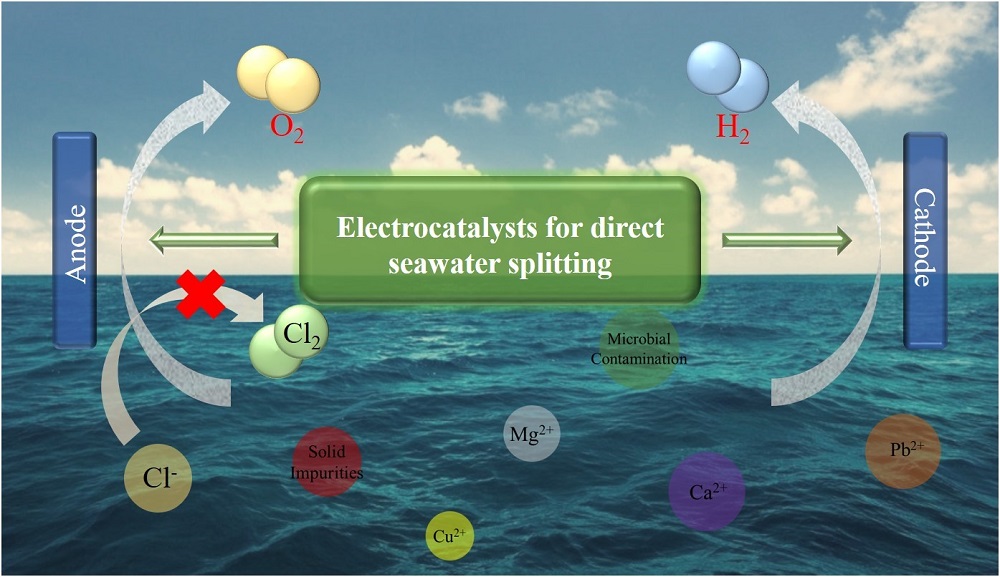1 Introduction
2 Overview of direct seawater electrolysis

Fig.1 Illustrations for the mechanisms of OER vs. chloride chemistry. (a) The Pourbaix diagram of an artificial model solution (0.5 mol·L–1 NaCl solution with electrolytes to control the pH and no other chlorine species) depicting the thermodynamic equilibrium of H2O/O2 (green line) and Cl–/Cl2-HOCl-OCl– (red line). Reprinted with permission from ref. [24], copyright 2016, Wiley-VCH. Free energy diagram over RuO2 (110) for (b) ClER Volmer-Heyrovsky mechanism and (c) two OER competing water splitting reactions (electrochemical and chemical pathway) at different potentials. Reprinted with permission from ref. [25], copyright 2018, American Chemical Society. (d) ΔGloss volcano diagram for OER (black) and chloride evolution reaction (ClER, gray). Reprinted with permission from ref. [26], copyright 2014, Wiley-VCH. |
3 Design of anode electrocatalysts for direct seawater electrolysis
Tab.1 Oxygen evolution electrocatalysts reported in saline electrolyte |
| Catalyst | Support | Electrolyte | Prominent performance | Ref. |
|---|---|---|---|---|
| (MnMo)Ox | IrO2/Ti | 0.5 mol·L–1 NaCl | OER selectivity of 91% | [36] |
| (Mn-W)Ox | IrO2/Ti | 0.5 mol·L–1 NaCl | OER selectivity of 99.6% | [37] |
| Co3O4 | Ni foam | 1 mol·L–1 KOH+ natural seawater | Overpotential: about 280 mV for HER and 450 mV for OER at 100 mA·cm–2 | [38] |
| Co-Fe-O-B | Glassy carbon | 1 mol·L–1 KOH+ 0.5 mol·L–1 NaCl | Overpotential: 294 mV for OER at 10 mA·cm–2 | [39] |
| (Mn0.88Mo0.12)O2.12 | IrO2/Ti | 0.5 mol·L–1 NaCl | OER selectivity of 99.6% after 1500 h electrolysis at 100 mA·cm–2 | [40] |
| NiFe-LDH | Membrane | 0.5 mol·L–1 KOH+ 0.5 mol·L–1 NaCl | Stable electrolysis at 200 mA·cm–2 for 100 h | [41] |
| S-(Ni,Fe)OOH | Ni foam | 1 mol·L–1 KOH+ natural seawater | Overpotential of 300 and 398 mV for OER at 100 and 500 mA·cm–2 | [42] |
| NiCoS | Ni foam | 1 mol·L–1 KOH+ natural seawater | Stable electrolysis at 800 mA·cm–2 | [43] |
| RuO2:Zn | Ti mesh | 150 mmol·L–1 NaCl+ 0.1 mol·L–1 HClO4 | Change of selectivity by the incorporation of Zn | [44] |
| Pb2Ru2O7−x | Glassy carbon | 0.1 mol·L–1 NaOH+ 0.6 mol·L–1 NaCl | OER selectivity of 99% at pH= 13 and 5 h stable electrolysis at 200 mA·cm–2 | [45] |
| Co-Se4 | Co foil | Buffered seawater (pH= 7.09) | 10.3 mA·cm–2 at 1.8 V for overall seawater electrolysis | [46] |
| Co-Pi | Glassy carbon | 0.5 mol·L–1 NaCl+ 0.1 mol·L–1 Pi (pH= 7.0) | Retained activity for O2 generation in Cl–-containing electrolyte | [47] |
| Co/Co3O4@C | Carbon fiber paper | 1 mol·L–1 KOH+ natural seawater | Overpotential: about 600 mV for HER and 630 mV for OER at 10 mA·cm–2 | [48] |
| Co-Fe LDH | Ti mesh | Simulated seawater (pH= 8.0) | Stable electrolysis for a diurnal cycle (8 h·d–1) | [49] |
| MnOx/IrOx | Glassy carbon | 30 mmol·L–1 KCl+ 0.5 mol·L–1 KHSO4 | CER selectivity decreased from 86% to 7% by MnOx deposition | [50] |
| CaFeOx|FePO4 | FTO | Buffered synthetic seawater (pH= 7.0) | Overpotential: about 710 mV for OER at 10 mA·cm–2 and stable electrolysis for over 10 h | [51] |
| GO@Fe@Ni-Co | Ni foam | 1 mol·L–1 KOH+ 0.5 mol·L–1 NaCl | 20 and 1000 mA·cm–2 at 1.57 and 2.02 V for overall seawater electrolysis | [52] |
| NM/IrO2 | Ti mesh | 0.5 mol·L–1 NaCl (pH= 8.3) | OER selectivity of nearly 100% by Nafion coating | [53] |
| NiFe/NiSx | Ni foam | 1 mol·L–1 KOH+ 0.5 mol·L–1 NaCl | Stable electrolysis at 1000 mA·cm–2 for over 500 h | [54] |
3.1 Restricting chloride chemistry thermodynamically

Fig.2 Maximum allowed overpotential region where only OER is thermodynamically possible in seawater electrolysis. The E–EOER values are the difference between chloride-related reactions (chlorine evolution, hypochlorous acid formation and hypochlorite formation reaction) and OER at different pH values. Reprinted with permission from ref. [24], copyright 2016, Wiley-VCH. |
3.2 Active species selective to OER

Fig.4 (a) Original current density (black) and current densities attributed to oxygen (black) and chlorine (red) for anodic OER in 0.1 mol·L–1 HClO4 + 0.14 mol·L–1 NaCl solution. Reprinted with permission from ref. [44], copyright 2010, Wiley-VCH. (b) OER current efficiencies at various potentials for PbRu2O7 and RuO2 in 0.6 mol·L–1 NaCl. Reprinted with permission from ref. [45], copyright 2020, American Chemical Society. (c) Polarization curves of Co-Se1//Co-Se4 and Ir-C//Pt-C in buffer solution and seawater. Reprinted from with permission ref. [46], copyright 2018, Wiley-VCH. |
3.3 Protecting layers

Fig.5 (a) Sketch of OER and ClER on IrOx/GC catalyst with and without MnOx deposition. Reprinted with permission from ref. [50], copyright 2018, American Chemical Society. (b) Representation of the improved selectivity and stability on active NiFeOx catalyst with CeOx deposition. Reprinted with permission from ref. [62], copyright 2018, Wiley-VCH. (c) Schematic illustration of the preparation of GO@Fe@Ni-Co@NF. Reprinted with permission from ref [52], copyright 2020, Royal Society of Chemistry. |
4 Design of cathode electrocatalysts for direct seawater electrolysis

Fig.6 (a) Reduction potential-dependent sequential reduction of platinum group metal (PGM) in Ni-Mo matrix; (b) hydrogen evolution polarization curves of Pt/C and Pt/Ni-Mo; (c) the comparison of the Pt/Ni-Mo and other PGM-based and Non-PGM catalysts. Reprinted with permission from ref. [63], copyright 2021, Wiley-VCH. |

Fig.7 Schematic illustration of the preparation of nitrogen-deficient 2D MoN and nitrogen 2D Mo5N6 electrocatalysts through an ammonization synthesis without and with Ni-induced process, respectively. Reprinted with permission from ref. [73], copyright 2018, American Chemical Society. |
5 Design of bifunctional electrocatalyst for seawater electrolysis
6 Design of seawater electrolysers

Fig.9 (a) Schemes for AEMWE using asymmetric feeding electrolyte with different electrolyte composition. Reprinted with permission from ref. [98], copyright 2020, Royal Society of Chemistry. (b) Scheme of a GO device for concentration-cell measurements, hydrogen pumping and water vapor electrolysis. Reprinted with permission from ref. [100], copyright 2018, American Chemical Society. |





